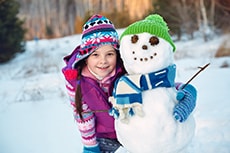
by NIAS | Dec 1, 2023 | Family Activity
Winter Activities
From Early Childhood News
Fill an empty grapefruit half with birdseed and suspend with rope or wire from branch.
Next time it’s snowing, chill a sheet of black construction paper in the freezer for 30 minutes; catch snowflakes on it. Look at each snowflake with a magnifying glass.
From Nature Conservancy Activitiy Guide
Take a winter walk around the yard, around the neighborhood, or at the park or nature preserve. Make a list of wintering birds, berries, tracks, tunnels – and don’t forget to look under logs to see what is sheltering there. Replace log. Then go in and have hot chocolate and snacks and talk about discoveries.
For very young children: hide stuffed animals in the yard, then go on a safari to find them; along the way, note the real animals, birds and other signs of winter. Build a snow fort. Pile snow, excavate a wide entrance and shovel out a place to sit.
Winter Fun
Make a snow angel; a partner helps the angel-maker get up neatly, without disturbing the edges.
Sprinkle cups of birdseed into the head and body. Add pine cones for angel’s spreading wings.
Snowman Race
Snowman Race: Have 2 kids or 2 teams make snowmen bottoms; at GO, they finish the snowman – body, hat, nose, etc.
Ideas from Outside Winter Time Fun by Barbara Shelby.
Winter Trees
Take a walk in your yard or neighborhood or park paying attention to trees—and don’t forget binoculars! Look for differences in evergreen trees; if possible, identify some; at least note the different shapes, needles, and cones. Look up high in the evergreen trees for cones still on them. Look up high in the deciduous trees and notice the branches and knobs. With the leaves gone, these are easier to see.
Search for animal homes in deciduous trees. Look for evidence of ways animals survive in winter.
Don’t forget to pack some peanut butter or suet into crevices of a large pinecone and roll in peanut butter and hang for the birds. Put some birdseed in an orange half or grapefruit half that has been hollowed out and hang from a tree branch.
Then have some hot chocolate – with lots of marshmallows!
Winter Stroll
Take a winter walk around the yard, around the neighborhood, at a park or nature preserve.
Make a list of wintering birds, berries, tracks, tunnels – and be sure to look under logs to see what is sheltering there. (Replace log.)
For very young children: hide stuffed animals in the yard and go on a safari to hunt for them; along the way, note real animals, birds, and signs of winter.
Afterwards, go in and have hot chocolate and talk about what you saw. Talk about birds like the chickadee and cardinal who stick around all winter; perhaps you can cut out pictures of some of these and paste onto construction paper to make a little book.
Fun in the Snow
As we go into winter and get closer to Christmas, a fun project you can do with your family and friends is to make reindeer food! You’ll need a bowl, something to store your food in, oats, bird seed, and peanuts. Mix two cups of oats, one cup of bird seed, and one cup of peanuts in your bowl. Save your reindeer food until Christmas eve, then sprinkle it in the yard for when Santa and the reindeer come, so the reindeer will have a snack, too!
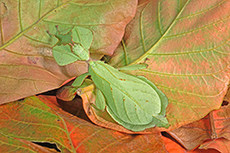
by NIAS | Nov 1, 2023 | Family Activity
Family Activity
Learn about leaves!
You will likely be surrounded by leaves at this time, so why not learn about leaves while doing some art.
First, go on a hike where there are different tree species and collect as many different leaves as you can. What colors leaves do you find? Why are the leaves no longer green? Compare the leaves to each other. Do they have pointy edges or round edges? Are they smooth or serrated? Smell the difference between old leaves and new leaves. Crumble some of the leaves. Do they have different textures? If you have a tree identification guide, see if you can identify what species these leaves belong to.
Now do some leaf art! Create birds or other animals using the different leaves you have in front of you. Many leaves resemble the wings or tails of a bird. You can even glue them onto paper and share your leaf art with others.
Search for Hidden Creatures!
Is that leaf really a leaf? Or is it a butterfly or a katydid? Is that stick really a stick? Or is it a walking stick insect? Autumn is a time for animals to start migrating or preparing for winter. As plants start to turn brown and many leaves fall to the ground, many creatures use them for shelter and hiding places. As you explore, slowly and carefully look under twigs, rocks, tree bark for hidden creatures. Also look for animals hiding in plain sight. Many animals stay quiet and motionless until you walk away from them. Look high and low for these creatures and learn about camouflage and mimicry along the way. When you are done, play hide-and-seek with your family members!
Autumn Leaves
Make a Placemat or Bookmark with Colored Leaves
- Collect the colored leaves, noting the different shapes and colors.
- Talk about the trees from which these leaves fell: have the kids learn to identify two or three trees like maple or oak by their leaves.
- Take the leaves inside; have the kids choose the ones they want and arrange them on pieces of poster paper.
- Cover with clear Contac.
- As you do this, talk about why the leaves change color – an excellent book for this is Why Leaves Change Color by Bette Maestro and Loretta Krupinski; for children 7 and up, another good one is one by the same title by Terri Hicks.
Explore the Trees in Your Yard
- Which birds and animals depend on the trees?
- How do the birds and other animals use the trees to help them get ready for winter?
- Talk about the tree as a habitat or living space.
- Compare a tree to your own home or habitat. How are they alike and different?
Be Sure to Jump in a Pile of Leaves!
Autumn Activities
Begin with a scavenger hunt and/or photography hunt for the signs of autumn. You can have a checklist — or actually collect the objects as long as they are common objects like colored leaves and nuts (but no flowers/plants from nature preserves or state parks).
With photography you might emphasize the array of colors, print the pictures and make a collage of the color variations.
You can also photograph signs that show evidence of animal homes, including scat. Perhaps you can capture a picture of a squirrel with nuts, with great luck perhaps migratory birds passing through, along with pictures of year-round bird residents.
Do an autumn texture collage. On a walk feel the textures and notice the colors of the signs of autumn you can collect — the leaves, the acorns or other nuts, berries, tree bark, a sprig from an evergreen for contrast. Arrange on construction paper in a collage; glue or tape — and you can cover with clear Contact color. The nuts and bark may make it all a big knobbly and the berries may squirt a bit, but that makes it all the more exciting!
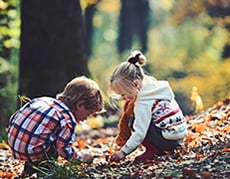
by NIAS | Oct 1, 2023 | Family Activity
Fall is an excellent time to learn about deciduous trees, such as oak trees and maple trees. A good activity for the family is to learn about the life cycle of an oak tree. Find an oak forest and start exploring and observing.
During autumn, deciduous trees start to lose their leaves, preparing for the dormant period of winter. Spend a few minutes underneath the trees and wait for some leaves and acorns to fall (watch out!). They are falling because now is the time for the seed to land on the ground and become covered by snow. The seeds will overwinter and upon spring, the little plant will emerge from the seed ready to become a mighty oak someday.
Examine an acorn for herbivore activity by looking for small holes. The acorn may have a tiny insect larvae inside, using the seed for nutrients. Or, watch squirrels scurry around, collecting acorns, also relying on the seed for food.
Also examine the leaves for herbivore activity. You may notice small bumps called galls, which the plant produces in response to insect larvae. Also take notice of the color change within the leaf – the green chlorophyll has likely disappeared, leaving red, orange, or yellow pigments to remain.
Finally, lay down in the bed of leaves and make a “leaf angel” similar to a snow angel in the winter! Using your senses, listen to the crunching sounds of the leaves and smell the scents of autumn.
Harvest Decorations
A fun activity you can do with your family and friends is decorating pumpkins. Each person can pick out their favorite color paints, and use them to paint their own pumpkin!
An easy craft that you can do in the fall is to make a pinecone birdfeeder! All you need is a pinecone, peanut butter, bird seed, and string. First, spread the peanut butter on the pinecone, then roll it in birdseed so the birdseed sticks to the peanut butter. Next, tie the string around the top of the pinecone and hang it from a tree.
Leaf Fun
There are many leaves strewn on the ground: pick one up and ask your children to find another leaf that is the same color the same shape. This seems simple, but many kids group all leaves together and may have never noticed the different shapes.
Put your hand on a tree and ask your kids to find a similar tree. Ask your kids to notice the texture of the bark or the shape of the leaves. It isn’t necessary that they identify the tree as oak or maple, just encourage them to notice that all bark is not the same and not all leaves aren’t the same shape.
Then, depending on the ages of the kids, you may want to do some simple tree identification. But the most important thing with this is just to notice differences.
Have your kids collect some leaves and have each one choose a favorite. Have the child observe that leaf closely. Take that leaf and choose another 3 or 4 leaves for this game. Have the child stand in front of you with hands behind their back. Set a leaf in the child’s hand and have them examine the leaf with their fingers.
Is this their favorite leaf? Try one leaf after another until the child identifies the favorite leaf by touch alone. Can they tell you what the identifying feature was? If there are several kids, they can pair up to play the game.
Have your kids collect as many leaves as they can in 15 seconds. Clear a spot on the ground and have the kids sort the leaves into whatever groupings they would like – can group by size, shape, color, insect damage or whatever works in that setting.
Autumn Scavenger Hunt of the Senses
Make a list or, better yet, a chart with picture:
- To Find: pine cone, acorn, red leaf, apple, twig, feather (and any other color leaf or any item to add)
- To Look For: Spider web, a leaf falling to the ground, clouds, a bug
- To Listen For: Leaves under feet, wind in trees, chipmunks and squirrels scampering through leaves, calls of birds of fall/winter – bluejays, crows, chickadees, etc.
- To Smell: pine, cedar, a fall flower, decomposing leaves
Then go home, have some hot chocolate and talk about your findings.
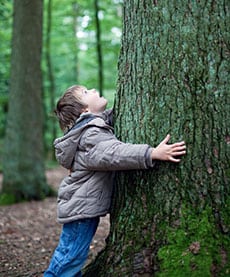
by NIAS | Sep 1, 2023 | Family Activity
What do birds eat and how do they eat it?
Look at some bird pictures and point out the beaks, explaining that every bird has a beak that is shaped to help it hunt and eat its own food. Then you can try out these techniques:
Eat like a robin: Embed gummy worms in a cake pan full of packing noodles. Have the child try to spear the gummy worms with tweezers.
Eat like a hummingbird: Have the child suck up a little sugar water, using a straw for a beak and fitting the straw through a hole in a piece of paper or foil covering a glass.
Eat like a cardinal: Use a nutcracker to crack sunflower seeds or something of similar hardness. Point out the wide, strong beak of the cardinal. Perhaps you can make a beak that is like that of a cardinal.
Eat like a woodpecker: Help a child peck hard at an old piece of wood with a screwdriver or other hard, pointed object; you can keep your hand over the child’s to prevent a drilled thumb or finger. You can put Cheerios on the other side and draw those out to show that the woodpecker has successfully found the insects. Roll a small piece of paper into a funnel shape and coat it with a little honey to show the long, sticky tongue that is going to pull out the Cheerios.
Eat like a flycatcher: Put a cheerio on a string and have the child perch on an ottoman or small chair and try to snatch the cheerio as you swing it by. Then, have him “fly” after the insect/cheerio as you whisk it around the room.
Eat like a finch: Put some Rice Krispies in a small cardboard box with holes in it; have him get the krispies with tweezers.
Eat like a chickadee/sparrow, etc.: Put the cheerios in a bowl and let him eat – no hands allowed.
Eat like an eagle, hawk, etc.: Let the child pounce on a small stuffed animal – you can add the sharp or hooked beak and talons when the child is old enough not to be frightened by that aspect. According to the age of the child, you can show the various kinds of woodpeckers, flycatchers, finches, etc.
Meet a Tree!
Touch a tree; rub your cheek on the bark. Is it rough or smooth?
Is this tree alive?
Can you put your arms around it?
Is it older than you are?
Can you find plants growing on it?
Do you see or hear any birds in the tree?
Any squirrels?
From Sharing Nature with Children, Joseph Cornell
Trees as Habitats
What are some plants and animals that depend on trees?
What do trees provide for these plants and animals?
Can you see signs of life on the trunk, branches, roots, and leaves?
How is a tree affected by the plants and animals that live on it?
From Project Learning Tree, Forest Foundation
Attract Hummingbirds
Hang a hummingbird feeder in a spot where you can easily see it. Since hummingbirds are territorial, you might want to hang two, one in front and one in back.
Food: 1 part sugar to 4 parts water. Boil the water to kill bacteria or mold. Add the ¼ cup sugar to 1 cup water. Cool. Excess mixture can be saved for up to two weeks in the refrigerator.
Do not add food coloring, honey (it ferments), or sweetener.
Clean at least once a week, more often if water gets cloudy. To clean, use 1 part white vinegar to 4 parts water: rinse 3 times to make sure all vinegar is gone. If mold develops, clean with a 10% bleach solution and rinse several times.
Water will keep out ants; many feeders have water containers on top.
Flowers with bright, rich colors are most likely to attract hummingbirds; long or tapered shapes help to accommodate the long bills. Native species are preferred. Some flowers that are likely to attract hummingbirds are bee balm, cardinal flower, zinnia, salvia, bleeding heart, lupine, columbine.
You can make your own feeders with tall, narrow bottles and feeding tubes, which come 12 to a pack.
With simple hand lenses, explore in minute detail such wonders of nature as the hairs on leaves or the intricacies of flower parts.
Match nature’s colors: Put crayon, marker or colored pencil color markings on index cards and match with findings in nature. How many shades of green and brown can you find? Can you find all colors of the rainbow?
Summer Outdoors
Many ideas for summer fun for kids and their families in Summer Activities: Nature Activities for Children, by Irmagard Kutsch, Brigitte Walden (illus.).
On a rainy day, go outside during or after a rain to listen, smell, touch and see its effects. Ideas from Listen to the Rain, by Bill Martin Jr. and John Archambault.
If it is raining, would you describe it as soft and slow, roaring and pouring, hurly-burly, topsy-turvy, ligihtning-flashing, thunder clapping, sounding pounding roaring or dripping.
- Can you see raindrops of different sizes?
- Can you find any animals moving during or after a rain? Which ones?
- Which plants still hold some rain drops in certain places? Where?
- What can you smell after a rain?
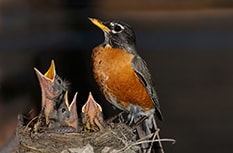
by NIAS | Aug 1, 2023 | Family Activity
Family Activity
What do birds eat and how do they eat it?
Look at some bird pictures and point out the beaks, explaining that every bird has a beak that is shaped to help it find and eat its own food. Then you can try out these techniques:
- Eat like a robin: Embed gummy worms in a pan full of dried oats. Have the child try to spear the gummy worms with tweezers.
- Eat like a hummingbird: Have the child suck up a little sugar water, using a straw for a beak and fitting the straw through a hole in a piece of paper or foil covering a glass.
- Eat like a cardinal: Use a nutcracker to crack sunflower seeds or something of similar hardness. Point out the wide, strong beak of the cardinal.
- Eat like a woodpecker: Help a child peck hard at an old piece of wood with a screwdriver or other hard, pointed object; an adult can help to make sure there are no injuries. Another idea is to take a paper towel roll poked with holes and put small pieces of gummy worms partially seen from the outside. The child has to pull the worm out through the hole, similar to what a woodpecker would do.
- Eat like a flycatcher or a swallow: Have the child catch some popped popcorn or light cereal that you throw into the air. For more fun, hang the food on a string and have them chase after the “fly” around the room.
- Eat like a finch: Put some rice cereal in a small cardboard box with holes in it; have them get the cereal out with tweezers.
- Eat like a chickadee/sparrow, etc.: Put the cereal in a bowl and let them eat – no hands allowed.
- Eat like an eagle, hawk, etc.: Let the child pounce on a small stuffed animal – you can add the predator/prey information if appropriate for age.
Family Activity
Explore the water!
Go with a parent or adult to a pond or creek. Bring a net, coffee can, bucket, or any other container. Don’t forget to wear boots and prepare to get wet!
Scoop up the water and make sure to gather a lot of the dirt at the bottom – some of the most interesting creatures are hiding down there! These creatures tend to be scavengers and detritivores, digesting dead material and returning them back to the water. They play an important role for the health of the aquatic ecosystem.
You may find invertebrates, such as dragonfly, damselfly, and mayfly larvae as well as adults of these larvae flying around. You may also see giant water bugs, water striders sliding along the surface of the water, diving beetles, water boatmen, and water scorpions. You may find larger invertebrates like a crayfish scurrying along the bottom. Be on the lookout for vertebrates such as minnows or larger fish, amphibians like frogs and toads, reptiles like turtles and snakes, and maybe even mammals swimming in the water!
Anything you collect, make sure to treat them with respect and care and put them back in the water when you are done.
Here is a cool resource created by entomologist Moriya Rufer from the University of Minnesota to help in identification!
Safety tips – make sure to use caution around slippery rocks. Algae or moss growing on a rock makes them slippery, so always check that you have secure footing. It’s best not to jump from rock to rock. Crayfish have some strong claws – be careful when handling them to avoid pinches! Similarly, be careful with some insects, especially the giant water bug – because they are predators, they can have a painful bite (they are nicknamed toe-biters!). A change of clothes for the trip back home is also helpful!
Explore
Summertime is a great time to explore aquatic ecosystems! On hot days, what better way is there than to cool off from the hot sun by playing in water. Go with a parent or other adult to a pond or creek and learn how to play safely near water. Bring a bucket, fish net or sandbox sifter, and large white bowls or plates when you go. If you have a magnifying lens, bring that too!
Wade into the water carefully, scoop out some water with the mud from the bottom (that will get you some fun creatures) and dump it into your white containers. The white background will allow you to see specimens better. Look for water bugs, larvae of dragonflies, damselflies, and mayflies, snails, mussels, crayfish and much more! Don’t forget to put them back into their home in the water when you are done!
For younger children – learn about the properties of water by using a big bowl of water and placing objects into it. For example, discuss how objects float and sink by placing rocks, flowers, leaves, and other things in nature.
Go Mothing!
Summer is an excellent time to search for moths. There are a few simple ways to find them. Moths tend to be attracted to lights, so an easy way to attract them is to turn on a porch light and bring them close. To see them better, hang a white sheet on a clothesline or wall and shine a light onto it. Then just wait and see.
You can also attract moths by providing a sugary food. Make “moth food” – mix, sugar and a fruit, such as banana or peach. Then spread it on a tree trunk and check back as the sun sets.
Learn more
Late Summer into Fall
As we approach fall time, a fun activity you can do is to make leaf rubbings. All you need is a piece of paper, your favorite crayon, and a leaf.
First, go outside and retrieve a leaf off a nearby tree. Next, lay your leaf down on a flat surface and put the sheet of paper over it. If your crayon has a wrapper on it, peel it off. Then using the long side of the crayon, shade on the paper over the leaf. You’ll be surprised to see that you have just drawn the leaf you picked out!
As summer comes to an end and the weather cools off slightly, a fun thing to do with your family is to have a campfire and roast s’mores! To make s’mores around a campfire, all you need is graham crackers, chocolate, marshmallows, and a stick.
First, put your marshmallow on the end of the stick. Hold the marshmallow over the fire until it is cooked just how you like it. Then, put a piece of chocolate on a graham cracker, and use another graham cracker to sandwich the chocolate and the marshmallow in the middle. Enjoy!
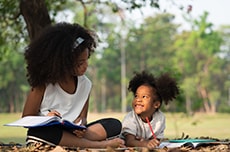
by NIAS | Jul 1, 2023 | Family Activity
Family Activity
Go insect hunting!
Insects are the most successful animals on the planet. They are amazing! They are the first organisms to fly! They can buzz! They can jump! They can sting! They have beautiful colors! Some even light up!
Learn about these creatures in your own backyard. To attract them, put something like banana out in an area outside. Spread the banana on a rock or bark of a tree for a short period of time. Check it regularly and see who has visited. With an adult, go out at night with a flashlight to see if there are different insects at nighttime.
Carefully catch an insect and look at it with a magnifying glass. (ask an adult first – some insects and spiders do bite or sting.) How many legs do you count? If you count six legs, three body regions, and two antennae – it is an insect. If you count eight legs, two body regions, and no antennae, it is likely a spider, which is not an insect! If there are too many legs to count, it could be a millipede or centipede!
If you want to watch an insect for a short period of time, place it in a jar with some sticks, leaves, and a little cap of water. Cover with a net or waxed paper with holes poked through. Return the insect back home within 24 hours or less!
Learn that insects are not here to harm you and you should not harm them. Teach others not to use pesticides in their lawns, not to use bug zappers, and also to turn off unnecessary lights at night. All of these kill, hurt, or confuse insects. Insects are important for the ecosystem and without them, we would also be harmed.
Explore the Colors of Nature
First, take pieces of strong paper or index cards and color them with different crayons, markers, or colored pencils. Take these cards outside and match them with what you can find in nature. How many different shades of green can you find? How many different shades of brown can you find? Can you find the colors of the rainbow?
Remember to look high and low! At this time of year, many flowers are blooming with different shades of color but don’t forget to look at what could be on or in the flower. The diversity of insects that visit the flowers is endless!
Observe the diversity of birds. Many birds appear one color, but at different angles, show a variety of other colors. For example, the Common Grackle may at first appear all black, but when the light strikes just right, you can see an iridescent rainbow. The male Ruby-throated hummingbird has a red throat at some angles, but it appears black at other angles. Other birds show their colors when their wings open – just wait and be patient and you might be able to see them show off their hidden colors!
For younger children, take a large piece of cardboard and make multiple circles, each with a different color outline. Ask your child to find loose items in nature and place them in the correct circle. This will incorporate early sorting skills, counting, and improve dexterity.
These activities are a great way for kids (and adults) to look closely and pay attention to what they are seeing.
Make your own Stained-Glass Planet Earth
Look up a picture of planet earth and notice that it is made up of more water than it is land. Sometimes we even call it planet ocean instead of planet earth!
On a sheet of paper, use crayons (and not markers or colored pencils) to color a picture of earth and all of the oceans. When done, turn your paper over. Then use a cotton ball dipped in a very small amount of vegetable oil and rub over the back side of your paper. The paper will turn transparent and the colors will come through. Allow the paper to dry. Then hang up your “Planet Ocean” in front of a window so light can shine through.
Another idea is to use clear contact paper and tissue paper. Cut out your earth and ocean pieces from different colors of tissue paper and place them on one sticky side of the contact paper. Cover with another piece of contact paper. Now you have a stained-glass earth to hang in front of a window.
Idea modified from dltk-kids.com






